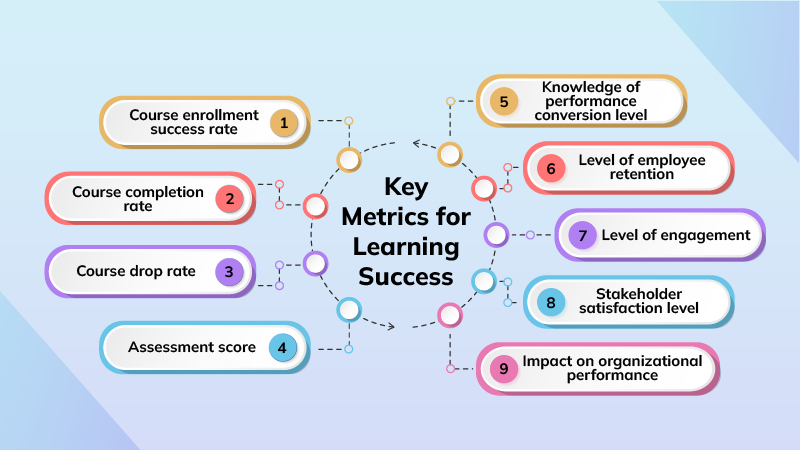In today’s rapidly evolving business landscape, continuous learning isn’t just a perk; it’s a strategic imperative. Companies are investing significant resources into e-learning solutions, ranging from comprehensive online learning platforms and curated online courses Australia offers, to specialized training like cpa online learning or technical skills development such as learning python. Yet, a persistent question lingers in boardrooms and finance departments: What’s the actual return on this investment? Moving beyond anecdotal evidence and focusing on concrete data is crucial. This post delves deep into how you can effectively demonstrate the tangible value – the Return on Investment (ROI) – derived from your company’s e-learning budget. We’ll explore the metrics, methodologies, and mindset shifts needed to transform learning expenditure from a cost center into a demonstrable value driver. This is about finding the hard evidence for learning.
The Evolving Landscape: Why ROI Matters More Than Ever
The digital revolution has reshaped how we work, collaborate, and learn. Traditional classroom training is increasingly supplemented, and sometimes replaced, by flexible, accessible online education learning. Platforms like LinkedIn Learning, Coursera, edX, and numerous others offer vast libraries catering to almost any conceivable skill gap. Companies utilize these for everything from onboarding new hires with structured online learning programs to upskilling existing employees in areas like data analysis, leadership, or even niche technical skills like mastering deep learning concepts.
The rise of blended learning models, combining online resources with face-to-face interaction, further complicates direct measurement. Furthermore, the accessibility of free online learning resources presents both opportunities and challenges. While potentially cost-effective, measuring the ROI of informal or free learning requires a different approach compared to structured, company-funded initiatives.
This shift necessitates a move towards quantifiable results. Simply stating that “employees are learning” is no longer sufficient. Leadership needs assurance that the investment in e-learning platforms, course subscriptions, and content development directly contributes to key business objectives like increased productivity, improved performance, enhanced innovation, reduced costs, and ultimately, greater profitability. Proving this link requires a structured approach to measuring the ROI of your online learning system.
Defining ROI in the Context of E-Learning
Traditionally, ROI is calculated as:
ROI (%) = [(Gain from Investment - Cost of Investment) / Cost of Investment] * 100
Applying this formula to e-learning requires careful definition of both “Gain” and “Cost.”
1. Cost of Investment: This is often the more straightforward component. It includes:
* Platform Fees: Subscription costs for online learning platforms (e.g., O’Reilly online learning, company-specific portals).
* Content Acquisition/Development: Costs associated with purchasing courses, licensing content, or developing bespoke e-learning modules.
* Technology Infrastructure: Any hardware, software, or bandwidth costs specifically supporting the e-learning initiatives.
* Implementation & Administration: Time and resources spent deploying the system, managing user accounts, and overseeing the program.
* Learner Time (Opportunity Cost): The value of the time employees spend learning instead of performing their regular job duties. This is often overlooked but crucial for a true cost picture. Consider the blended rate of employees undergoing training.
* Facilitator/Support Staff Time: Resources dedicated to answering queries, facilitating discussions, or providing technical support.
2. Gain from Investment: This is where the complexity lies. Gains aren’t always immediate or easily monetized. They can be categorized as:
* Direct Financial Gains: Cost savings (e.g., reduced travel expenses, lower turnover due to better engagement/upskilling), increased revenue (e.g., sales teams closing more deals after product training), improved efficiency leading to higher output.
* Indirect Financial Gains: Enhanced employee performance, improved customer satisfaction, faster time-to-market for new products/services, increased innovation, better compliance reducing risk and potential fines.
* Strategic Gains: Improved employee morale and engagement, stronger employer brand attracting top talent, development of a future-ready workforce capable of adapting to new technologies (like what is machine learning and its applications).
The challenge is quantifying these gains. This requires moving beyond simple completion rates and delving into measurable impacts on individual performance, team dynamics, and overall business metrics. Think about tracking the impact of english learning online programs on customer service interactions or the efficiency gains from learning python for your development team.
Setting Clear Objectives: The Cornerstone of Measurement
Before you can measure ROI, you must define what success looks like. Vague goals lead to vague results, making ROI measurement impossible. Objectives should be SMART (Specific, Measurable, Achievable, Relevant, Time-bound) and directly aligned with broader business goals.
- Instead of: “Improve employee skills.”
- Use: “Reduce the average bug resolution time for junior developers by 15% within six months by completing the recommended python learning online modules and practical exercises.”
- Instead of: “Enhance customer service.”
- Use: “Increase our customer satisfaction (CSAT) scores related to technical support queries by 10 points within one quarter, following the completion of the online courses focused on effective communication and product knowledge by the support team.”
- Instead of: “Ensure compliance.”
- Use: “Achieve a 100% completion rate and 90% pass rate on the compliance training module for all finance staff by [Date], tracked via the online learning system, reducing the risk of audit failures.”
Consider the specific needs related to certifications like CPA Australia. An objective might be: “Improve the pass rate for the internal CPA readiness assessment by 20% in the next cycle through targeted cpa online learning resources.”
Aligning learning objectives with tangible business outcomes is the critical first step. Whether it’s improving the efficiency of maths online problem-solving for engineers or boosting confidence in learning spanish online for international sales teams, the connection to business value must be explicit from the outset.
Key Metrics for Demonstrating E-Learning ROI

To build a compelling case, you need a robust set of metrics covering different aspects of the learning journey and its impact.
1. Learning Metrics (Kirkpatrick Level 1 & 2):
* Participation & Completion Rates: Track how many employees enroll in and complete specific courses or learning paths. Utilize data from your online learning platform or LMS. High dropout rates might indicate issues with content relevance, platform usability, or learner motivation.
* Assessment Scores: Measure knowledge acquisition through quizzes, tests, and practical assignments. Look for improvements over time or comparisons between trained and untrained groups. Platforms like IXL Learning or specialized assessment tools can provide granular data.
* Skill Proficiency: Use pre- and post-training assessments, simulations, or practical evaluations to measure the actual gain in specific skills. This is crucial for technical training like learning python or understanding concepts related to online machine learning.
* Time to Competency: Measure how long it takes for employees to reach a defined level of proficiency after training, especially relevant for new hires or new skill adoption.
2. Behavioral Metrics (Kirkpatrick Level 3):
* On-the-Job Application: This is a critical bridge between learning and performance. How are employees applying their new knowledge and skills in their daily work?
* Methods: Manager observations, 360-degree feedback, performance reviews incorporating specific learning goals, peer feedback, analysis of work output (e.g., code quality, report accuracy).
* Examples: Are managers seeing improvements in how employees handle specific tasks after completing a course on Dimensions Online or a similar platform? Is the language learning online program translating into more effective communication with international clients?
* Adoption Rates: Track the usage of new tools, processes, or techniques learned through e-learning.
3. Performance & Business Metrics (Kirkpatrick Level 4):
* Productivity: Measure changes in output, efficiency, or task completion speed. For example, did the online learning courses on process optimization lead to faster project delivery times?
* Quality Improvement: Track reductions in errors, defects, rework, or customer complaints. Did specific training on maths online accuracy reduce calculation errors in engineering?
* Sales Performance: Monitor increases in conversion rates, average deal size, or sales cycle length for sales teams who have undergone relevant training.
* Customer Metrics: Track changes in CSAT, Net Promoter Score (NPS), customer retention, or support resolution times.
* Innovation: Measure the number of new ideas generated or implemented by teams exposed to innovation-focused training.
* Compliance & Risk Reduction: Track adherence to regulations, reduction in safety incidents, or decrease in compliance breaches. This is vital for sectors requiring specific training like learning online qld health.
4. Financial Metrics (The Ultimate ROI):
* Cost Savings: Quantify reductions in traditional training costs (travel, venue hire, instructor fees), operational costs (reduced waste, fewer errors), recruitment costs (through internal upskilling and retention).
* Revenue Generation: Link learning initiatives directly to increased sales, new market penetration, or successful product launches.
* Profitability: Combine cost savings and revenue gains to calculate the net impact on the bottom line.
* Employee Retention: Calculate the cost of turnover (recruitment, onboarding, lost productivity) and correlate improved retention rates with investment in learning and development. High engagement via platforms like Alison online learning or comprehensive programs can significantly impact retention.
Leveraging Technology and Data Analytics
Modern online learning platforms and Learning Management Systems (LMS) are rich sources of data. Effective ROI measurement relies on harnessing this information.
- LMS Analytics: Most platforms provide dashboards tracking user progress, course completion, assessment scores, and engagement levels. Ensure your LMS allows for customization and reporting aligned with your specific objectives.
- Business Intelligence (BI) Tools: Integrate learning data with other business data sources (CRM, ERP, HRIS) for a holistic view. This allows you to correlate learning activities with specific business outcomes. For instance, connect sales training completion data with sales figures in your CRM.
- Learning Experience Platforms (LXPs): These platforms often offer more sophisticated analytics, focusing on user engagement, content relevance, and skill discovery, providing deeper insights than traditional LMS.
- AI and Machine Learning: The field of what is machine learning is increasingly applied within learning analytics. AI can help identify patterns in learning data, predict future performance, recommend personalized learning paths (e.g., suggesting ai courses online free or paid, relevant to an individual’s role), and even automate parts of the assessment process. This can refine the learning experience and potentially improve its ROI.
Don’t underestimate the power of simple tools either. Spreadsheets can be effective for tracking metrics, especially for smaller initiatives or specific projects like learning license test online preparation.
The Power of Qualitative Data
While quantitative metrics are essential for demonstrating financial ROI, qualitative feedback provides context, explains the ‘why’ behind the numbers, and captures benefits that are hard to quantify.
- Surveys: Use targeted surveys post-training to gauge learner satisfaction, perceived usefulness, and confidence in applying new skills. Ask specific questions related to the learning objectives.
- Interviews & Focus Groups: Conduct interviews with learners and their managers to gather in-depth insights into how the training has impacted their work, challenges faced in application, and suggestions for improvement.
- Testimonials & Success Stories: Collect compelling stories from employees about how specific e-learning initiatives helped them overcome challenges, achieve goals, or contribute to business success. These narratives can be powerful communication tools for stakeholders.
- Manager Feedback: Regularly solicit feedback from managers regarding the performance changes they observe in their team members who have undergone e-learning. This is crucial for validating behavioral changes (Level 3).
Qualitative data can highlight the impact of programs like free online courses or even informal learning activities that might not generate easily trackable quantitative data but still provide value. It also helps understand potential disadvantages of online learning experienced by users, allowing for course correction.
Practical Strategies and Examples
Let’s illustrate how this framework applies in practice:
Example 1: Upskilling Developers with Python
- Objective: Reduce bug resolution time by 15% in 6 months via python learning online modules.
- Investment: LMS subscription, developer time (2 hours/week).
- Learning Metrics: Course completion rates, coding assessment scores.
- Behavioral Metrics: Manager reports on code quality improvements, use of Python libraries learned.
- Performance Metrics: Track average bug resolution time pre- and post-training. Measure reduction in critical bugs.
- Financial Metrics: Calculate savings from reduced developer hours spent debugging, potential faster product releases.
- Qualitative: Developer interviews on confidence, new techniques learned.
Example 2: Enhancing Customer Service with Communication Skills
- Objective: Increase CSAT scores by 10 points in one quarter via english learning online communication course.
- Investment: Course fees for online learning platforms, agent time.
- Learning Metrics: Completion, role-playing assessment scores.
- Behavioral Metrics: Call monitoring scores focusing on clarity, empathy, and resolution effectiveness. Reduced escalation rates.
- Performance Metrics: CSAT scores, First Call Resolution (FCR) rates.
- Financial Metrics: Potential reduction in customer churn, increased customer lifetime value.
- Qualitative: Customer feedback mentioning improved service, agent feedback on handling difficult calls.
Example 3: Compliance Training for Finance
- Objective: 100% completion and 90% pass rate for cpa online learning modules by [Date].
- Investment: Platform access, employee time.
- Learning Metrics: Tracking completion and scores via the online learning system.
- Behavioral Metrics: Manager observation of adherence to new compliance procedures.
- Performance Metrics: Reduction in compliance errors identified in internal/external audits.
- Financial Metrics: Cost avoidance related to fines, penalties, or remediation efforts. Reduced audit costs.
- Qualitative: Audit team feedback on preparedness, finance staff feedback on clarity of regulations.
Incorporating Diverse Learning Needs:
- Specific Skills: Whether it’s cpa online learning, learning spanish online, or mastering specific software via linkedin learning, the principle remains: define the objective, measure the learning, track the behavior change, assess the business impact, and calculate the financial return.
- Platform Value: When evaluating platforms like Flinders Learning Online, Solent Online Learning, or even specialized tools like Widgit Online or Doodle Learning, assess their contribution to these metrics. Does the platform facilitate better tracking? Does its content demonstrably improve skills linked to business outcomes?
- Accessibility: Consider how different approaches like online distance learning or blended learning affect ROI. While potentially saving costs on travel, ensure engagement and effectiveness are maintained. The availability of free online courses can supplement formal training, but measuring their ROI often relies more heavily on qualitative assessments and observed behavioral changes.
- Regional Needs: For context like online learning NSW or learning online QLD Health, ROI might be framed around improved public service delivery, efficiency gains in healthcare administration, or better compliance with state regulations, translating metrics into public value alongside financial efficiency.
Avoiding Common Pitfalls
Measuring e-learning ROI isn’t without its challenges. Be aware of common mistakes:
- Lack of Clear Objectives: Failing to define specific, measurable goals tied to business outcomes makes ROI calculation meaningless.
- Focusing Solely on Learning Metrics: High completion rates don’t automatically equal business impact. Always strive to measure Levels 3 and 4 (Behavior and Results).
- Ignoring Costs: Forgetting to include the opportunity cost of employee time or administrative overheads leads to an inflated ROI.
- Insufficient Data Collection: Not having the right tools or processes in place to capture necessary quantitative and qualitative data.
- Attribution Challenges: Difficulty in isolating the impact of e-learning from other influencing factors. Use control groups where possible, or focus on correlations and trends over time.
- Short-Term Focus: E-learning benefits like cultural shifts, innovation, and strategic skill development often take time to manifest. Don’t expect immediate, massive financial returns on every initiative.
- Ignoring Qualitative Feedback: Relying solely on numbers can miss crucial context about learner experience and perceived value.
The Future: Predictive ROI and Continuous Improvement
The future of e-learning ROI measurement involves more sophisticated analytics. AI and machine learning can move beyond retrospective analysis to predictive modeling. By analyzing vast datasets, these technologies can help predict which learning interventions are most likely to yield desired business outcomes, optimize resource allocation, and personalize learning journeys for maximum impact. Imagine predicting which employees would benefit most from learning python based on their current performance data and career trajectory.
This focus on data allows for a cycle of continuous improvement: Measure -> Analyze -> Adapt -> Remeasure. By constantly evaluating the effectiveness of your e-learning initiatives against defined objectives and adapting your strategy based on the evidence, you can ensure your investment consistently delivers maximum value. This ongoing process turns learning into a dynamic, measurable driver of business success.
Conclusion: Building the Business Case with Evidence
Proving the ROI of your company’s e-learning budget is achievable, but it requires a deliberate, structured approach. It involves moving beyond vanity metrics like completion rates and focusing on measurable changes in behavior, performance, and financial outcomes.
By:
- Setting clear, business-aligned objectives.
- Identifying and tracking relevant learning, behavioral, performance, and financial metrics.
- Leveraging technology and data analytics effectively.
- Incorporating qualitative feedback for context and deeper insights.
- Avoiding common pitfalls and focusing on continuous improvement.
You can build a powerful, evidence-based case for the value your e-learning initiatives deliver. This data-driven approach not only justifies the budget but also optimizes future investments, ensuring that learning becomes a strategic asset that fuels growth, efficiency, and competitive advantage. Start collecting the evidence today – the true value of learning is waiting to be uncovered.












